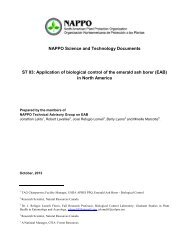NAPPO Regional Standards for Phytosanitary Measures (RSPM)
NAPPO Regional Standards for Phytosanitary Measures (RSPM)
NAPPO Regional Standards for Phytosanitary Measures (RSPM)
You also want an ePaper? Increase the reach of your titles
YUMPU automatically turns print PDFs into web optimized ePapers that Google loves.
egulated nonquarantinepeststandardsuppressionsurveillancesurveysystems approach (es)treatmentA non-quarantine pest whose presence in plants <strong>for</strong> planting affectsthe intended use of those plants with an economically unacceptableimpact and which is there<strong>for</strong>e regulated within the territory of theimporting contracting party. (FAO, 2002).Document established by consensus and approved by a recognizedbody, that provides, <strong>for</strong> common and repeated use, rules, guidelinesor characteristics <strong>for</strong> activities or their results, aimed at theachievement of the optimum degree of order in a given context.(FAO, 2002).The application of phytosanitary measures in an infested area toreduce pest populations. (FAO, 2002).An official process that collects and records data on pestoccurrence or absence by survey, monitoring or other procedures.(FAO, 2002).An official procedure conducted over a defined period of time todetermine the characteristics of a pest population or to determinewhich species occur in an area. (FAO, 2002).The integration of different pest risk management measures, atleast two of which act independently, and which cumulativelyachieve the appropriate level of phytosanitary protection. (FAO,2002).Officially authorized procedure <strong>for</strong> the killing or removal of pestsor rendering pests infertile. (FAO, 2002).Outline of RequirementsThis standard provides procedures <strong>for</strong> the establishment, maintenance, and verification of areasof low pest prevalence (ALPP) <strong>for</strong> insects. The standard outlines measures <strong>for</strong> maintaining thepopulation at low levels, monitoring the pest, quarantine operations, and emergency planningand response. The criteria <strong>for</strong> suspension, termination, and reinstatement of the ALPP areincluded. A bilateral workplan will typically be required to elaborate on the issues described inthis standard.BackgroundThe FAO definition of an area of low pest prevalence is, “An area, whether all of a country, partof a country, or all or parts of several countries, as identified by the competent authorities, inwhich a specific pest occurs at low levels and which is subject to effective surveillance, controlor eradication measures (IPPC, 1997).”Low pest prevalence can be applied to large geographic areas, smaller places of production suchas a block of contiguous orchards, and individual production sites. This is feasible provided thatcompliance with the established population threshold is achieved and maintained. Areas of lowpest prevalence must be isolated by a natural barrier or protected with buffer zones where<strong>RSPM</strong> No. 20Guidelines <strong>for</strong> the Establishment, Maintenance and Verification of an Area of Low Pest Prevalence <strong>for</strong> Insects Page 6
















